
Hebron is a Palestinian city in the southern West Bank, 30 kilometres (19 mi) south of Jerusalem. Nestled in the Judaean Mountains, it lies 930 metres (3,050 ft) above sea level. The second-largest city in the West Bank, and the third-largest in the Palestinian territories, it has a population of over 215,000 Palestinians (2016), and seven hundred Jewish settlers concentrated on the outskirts of its Old City. It includes the Cave of the Patriarchs, which Jewish, Christian, and Islamic traditions all designate as the burial site of three key patriarchal/matriarchal couples. The city is often considered one of the four holy cities in Judaism as well as in Islam.

The Cave of the Patriarchs or Tomb of the Patriarchs, known to Jews by its Biblical name Cave of Machpelah and to Muslims as the IbrahimiMosque, is a series of caves situated 30 kilometres (19 mi) south of Jerusalem in the heart of the Old City of Hebron in the West Bank. According to the Abrahamic religions, the cave and adjoining field were purchased by Abraham as a burial plot, although most historians believe the Abraham-Isaac-Jacob narrative to be primarily mythological.
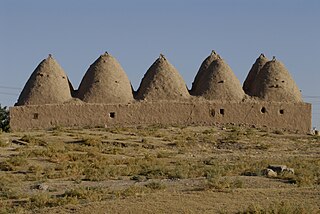
Harran, also known as Carrhae, is a district and town of Şanlıurfa Province in Turkey, 44 kilometers southeast of Şanlıurfa. It was a major city of the ancient Near East.

Sarah born Sarai is a biblical matriarch and prophetess, a major figure in Abrahamic religions. While different Abrahamic faiths portray her differently, Judaism, Christianity, and Islam all depict her character similarly, as that of a pious woman, renowned for her hospitality and beauty, the wife and half-sister of Abraham, and the mother of Isaac. Sarah has her feast day on: 1 September in the Catholic Church, 19 August in the Coptic Orthodox Church, 20 January the in LCMS and 12 and 20 December in the Eastern Orthodox Church.

Edessa was an ancient city (polis) in Upper Mesopotamia, founded during the Hellenistic period by King Seleucus I Nicator, founder of the Seleucid Empire. It later became capital of the Kingdom of Osroene, and continued as capital of the Roman province of Osroene. In Late Antiquity, it became a prominent center of Christian learning and seat of the Catechetical School of Edessa. During the Crusades, it was the capital of the County of Edessa.

Urfa, officially known as Şanlıurfa, is a city in southeastern Turkey and the capital of Şanlıurfa Province. Urfa is situated on a plain about 80 km east of the Euphrates River. Its climate features extremely hot, dry summers and cool, moist winters.

Mamre, full Hebrew name Elonei Mamre, refers to an ancient religious site originally focused on a single holy tree, growing "since time immemorial" at Hebron in Canaan. It is known from the biblical story of Abraham and the three visitors. The tree under which he had pitched his tent is known as the oak or terebinth of Mamre. Modern scholars have identified three sites near Hebron which, in different historical periods, have been successively known as Mamre: Khirbet Nimra, Ramat el-Khalil, and Khirbet es-Sibte. The last one contained an old oak tree identified by a relatively new tradition as the Oak of Mamre, which has collapsed in 2019, and is on the grounds of a Russian Orthodox monastery.
The Sabians, sometimes also spelled Sabaeans or Sabeans, are a mysterious religious group mentioned three times in the Quran, where it is implied that they belonged to the 'People of the Book'. Their original identity, which seems to have been forgotten at an early date, has been called an "unsolved Quranic problem". Modern scholars have variously identified them as Mandaeans, Manichaeans, Sabaeans, Elchasaites, Archontics, ḥunafāʾ, or as adherents of the astral religion of Harran. Some scholars believe that it is impossible to establish their original identity with any degree of certainty.
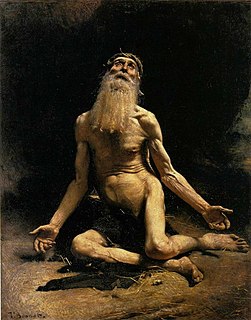
Job is the central figure of the Book of Job in the Bible. In rabbinical literature, Job is called one of the prophets of the Gentiles. In Islam, Job is also considered a prophet.
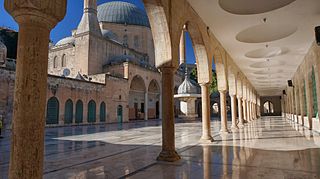
Şanlıurfa Province or simply Urfa Province is a province in southeastern Turkey. The city of Şanlıurfa is the capital of the province which bears its name. The population is 1,845,667 (2014). The province is considered part of Turkish Kurdistan and has a Kurdish majority with a significant Arab and Turkish minority.
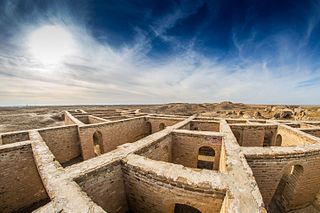
Ur Kasdim, commonly translated as Ur of the Chaldeans, is a city mentioned in the Hebrew Bible as the birthplace of the Israelite and Ishmaelite patriarch Abraham. In 1862, Henry Rawlinson identified Ur Kaśdim with Tell el-Muqayyar, near Nasiriyah in southern Iraq. In 1927, Leonard Woolley excavated the site and identified it as a Sumerian archaeological site where the Chaldeans were to settle around the 9th century BC. Recent archaeology work has continued to focus on the location in Nasiriyah, where the ancient Ziggurat of Ur is located.
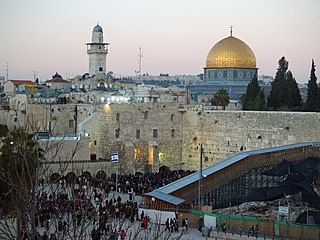
Tourism in Israel is one of Israel's major sources of income, with a record 4.55 million tourist arrivals in 2019, and, in 2017, contributed NIS 20 billion to the Israeli economy making it an all-time record. Israel offers a plethora of historical and religious sites, beach resorts, natural sites, archaeological tourism, heritage tourism, adventure tourism, and ecotourism. Israel has the highest number of museums per capita in the world. For practical reasons, this article also covers tourism in the Israeli-occupied West Bank and the occupied Golan Heights, since it is closely interconnected with the mass tourism in Israel.

The three holiest sites in Islam are: the Masjid al-Haram, including the Kaaba, in Mecca, as the holiest site; the Al-Masjid an-Nabawi in Medina, as the second holiest; and the Al-Aqsa Mosque compound, in Jerusalem, is Islam's third holiest site.

From the Holy Mountain is a 1997 historical travel book by William Dalrymple that deals with the affairs of the Eastern Christians.
In Abrahamic religious traditions, Dumah was the sixth son of Ishmael and grandson of Abraham and Hagar.
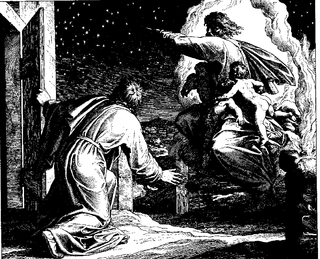
The ruins of the city of Harran, called Haran in the Hebrew Bible, might lie within present-day Turkey. Haran first appears in the Book of Genesis as the home of Terah and his descendants, and as Abraham's temporary home. Later biblical passages list Haran among some cities and lands subjugated by Assyrian rulers and among Tyre's trading partners.

The Road of the Patriarchs or Way of the Patriarchs, is an ancient north–south route traversing the land of Israel. The name is used by biblical scholars because of mentions in biblical narratives that it was frequently travelled by Abraham, Isaac and Jacob.

Ismail is regarded as a prophet and messenger and the founder of Ishmaelites in Islam. He is the son of Ibrahim (Abraham), born to Hajar (Hagar). Ismail is also associated with Mecca and the construction of the Kaaba. Ismail is considered the ancestor to Muhammad.
William Ury is an American author, academic, anthropologist, and negotiation expert. He co-founded the Harvard Program on Negotiation. Additionally, he helped found the International Negotiation Network with former President Jimmy Carter. Ury is the co-author of Getting to Yes with Roger Fisher, which set out the method of principled negotiation and established the idea of the best alternative to a negotiated agreement (BATNA) within negotiation theory.
Balıklıgöl, is a pool in the southwest of the city center of Şanlıurfa, Turkey known in Jewish and Islamic legends as the place where Nimrod threw the Prophet Abraham into a fire. Balıklıgöl and neighbouring Aynzeliha pools are among the most visited places in Şanlıurfa.


















